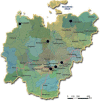Dietary intakes of energy and macronutrients by lactating women of different ethnic groups living in Yakutia
- PMID: 23971015
- PMCID: PMC3749853
- DOI: 10.3402/ijch.v72i0.21519
Dietary intakes of energy and macronutrients by lactating women of different ethnic groups living in Yakutia
Abstract
Background: There should be a substantial increase in the intake of dietary energy, protein and other nutrients by lactating women, though these special increments can be different in different ethnic groups.
Objective: To evaluate the influence of maternal ethnicity and diet on the quality of breast milk and its potential effect on early childhood development.
Design: A total of 185 mothers (150 Native and 35 Russian) living in settlements and small towns of rural Yakutia and 54 mothers (26 Native and 28 Russian) living in Yakutsk were surveyed and average food intake was recorded during 3 successive days before the survey was analyzed.
Results: The amount of protein varied from 18 to 168.3 g/day, fat--from 12 to 176.1 g/day, energy--from 900 to 3680.4 kcal/day. Protein intake was at the level of current recommended dietary allowances (RDA) in Russians and was higher than in Natives living in rural settlements and small towns (p = 0.02) and in Yakutsk (p = 0.03). Carbohydrate intake was higher, though not significantly, in both ethnic groups compared with the current recommendations. Protein, fat, carbohydrates and, therefore, energy intake were lower (p < 0.03) in Native women living in Yakutsk compared with the intake of Native women living in rural settlements and small towns.
Conclusions: The dietary intakes of energy and macronutrients depended on the place where a woman lived rather than on her ethnicity. Overall, energy intake was considered to be at the lower limit (basal energy expenditure 2002/2005) for lactating women, with the exception of Native women living in Yakutsk whose energy intake was below the lower limit.
Keywords: cross-sectional survey; indigenous people; lactation; macronutrients' intake.
Figures



References
-
- Chasnyk VG, Avrusin SL, Asaulenko VI, Shepovalnikov VN, Onoshko VA, Teshebaev ShB. Methodology and results of prophylactic examination of children. In: Degteva GN, editor. Saint-Petersburg: Paulsen; 2011. pp. 373–91. Problems of healthcare and social development of Russian Arctic. [in Russian]
-
- Rakibul I, Mashhood AS. Cultural and socio-economic factors in health, health services and prevention for indigenous people. Antrocom Online J Anthropol. 2010;6:263–73.
-
- Nikolaeva LA. Ethnic and regional features of arterial pressure and salt taste sensitivity in children living in Republic of Sakha (Yakutia). [dissertation]; Saint-Petersburg: State Pediatric Medical Academy; 2008. p. 114. [in Russian]
-
- Laskovik ATs. Scientific grounds for a system of health care for children living in rural areas of far north with low density of population. [dissertation]; Saint-Petersburg: State Pediatric Medical Academy; 2004. p. 338. [in Russian]
-
- Chasnyk VG, Burtseva TE, Dranaeva GG, Verbitskaya LI, Shadrin VP, Nikolaeva LA, et al. Anthropometric characteristics and arterial pressure in children living in the Republic of Sakha (Yakutia). Guidelines; Yakutsk: Dani Almas; 2009. p. 47. [in Russian]
MeSH terms
Substances
LinkOut - more resources
Full Text Sources
Other Literature Sources
